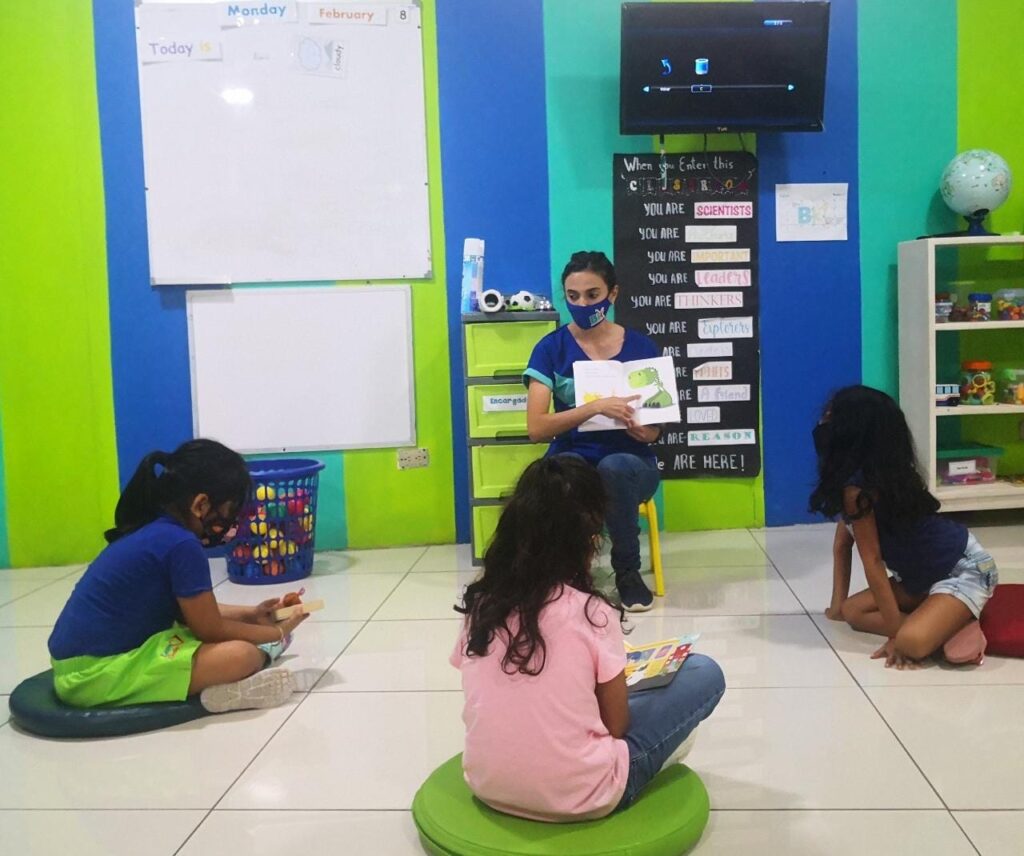TPRS is a method of acquiring a second language naturally and effectively. It’s an excellent tool to use with students of all ages but is especially effective with young learners due to its engaging nature. Below, we’ll look at how TPRS applies to language learning and explore some TPRS activities you can use in your own classroom!
What is TPRS in language learning?
What does TPRS stand for in education?
TPRS (Teaching Proficiency Through Reading and Storytelling) is a second language acquisition method. The method uses storytelling as a teaching tool. In the TPRS class, the teacher and students co-create stories in the target language to facilitate language acquisition.
What does this teaching method entail?
Language acquisition refers to the largely intuitive process through which the learner absorbs a language. When looked at from the learner’s perspective, it differs markedly from language learning. In language learning, students actively study new words and grammar rules; they rely on memorization and practice to assimilate a new language.
In contrast, language acquisition relies on exposure to the target language, contextualization (language is given in a context that facilitates understanding of unknown words and grammar), and repetition, in an organic process that seeks to mimic the way children learn their first language. The TPRS class feels less like a lesson and more like a conversation. Teachers seeking to improve students’ fluency can significantly benefit from applying this ESL teaching method.
Where does TPRS come from?
Before getting into the details of how TPRS works, let’s briefly examine its origins and then dive into the data regarding its benefits.
The TPRS method was created in the late 1980s by Blaine Ray. A Spanish teacher, Blaine sought to help his students attain fluency. He was familiar with the TPR (Total Physical Response) and Comprehensible Input (CI) approaches to teaching. In the TPR approach developed by James Asher in the mid-1960s, the instructor ‘contextualizes’ the new vocabulary by pointing to objects or mimicking specific actions, thus rendering the new words understandable. The CI approach posits that to acquire a new language, students need a) a lot of exposure/linguistic input and b) the input must be mostly comprehensible. Incomprehensible input that cannot be guessed through the context of the communication is akin to white noise and does nothing to advance students’ fluency.
Initially, Ray made ample use of TPR in his classes; however, he soon realized that while TPR works very well when teaching concrete words, it falls short when dealing with abstract terms and concepts. TPRS was Ray’s attempt to incorporate TPR and the theory of CI into his teaching method and to overcome the limitations of TPR. In its first incarnation, TPRS stood for Total Physical Response Storytelling. The acronym’s meaning later morphed into Teaching Proficiency Through Reading and Storytelling, thus reflecting the evolution of the method and its inclusion of reading as an important learning tool.

What are the benefits of TPRS?
TPRS language learning has increased in popularity since its inception. The main reasons for its popularity are that:
- It produces tangible results.
- It’s engaging and fun for students.
- Once the technique is learned, it relieves teachers from much of the class preparation burden.
- TPRS creates an atmosphere of focused but relaxed learning, effectively removing students’ anxiety.
In her book, Teaching Proficiency Through Reading and Storytelling (TPRS) – An Input-based Approach to Second Language Instruction, TPRS researcher Karen Lichtman states that “TPRS shows the clearest advantage for the acquisition of vocabulary and grammar, as well as the development of reading and speaking skills. Additionally, TPRS outperforms other methods on rate of learning; students in TPRS classes get more language and more skills than in traditional classes” (Lichtman, 2018).

How do you use the TPRS method?
The three phases of TPRS
The TPRS method has three essential phases. Let’s take a closer look at these.
Phase 1: Establishing Meaning
In this first phase, the teacher explains the new vocabulary that will be used in the lesson. This is done through TPR for words referring to concrete objects or actions (e.g., ‘boy,’ ‘goes,’ ‘finds,’ ‘cat,’ etc.). For abstract concepts, the teacher provides a translation in the students’ language.
ESL teachers whose students have multiple linguistic backgrounds or those who do not speak their students’ language can use presentations with pictures to convey the new vocabulary. They will also rely more heavily on TPR. Another way ESL teachers can establish meaning is TAG: Translation (the direct translation of the word), Association (what does this word remind you of?), and Gesture (associating a gesture to the word).
Establishing meaning involves many repetitions of the new vocabulary to ensure the students assimilate and are eventually ready to use it. How to accomplish this will be explained below.
See how a teacher uses a simple presentation to establish meaning in the video below, from English Comprehensible Input for ESL Beginners:
Phase 2: Ask a Story
The second phase of the TPRS method is to ask a story. The wording is significant here. The TPRS teacher does not tell a story. Instead, she co-creates the story with her students by asking them to add details or characters. Asking a story emphasizes the collaborative nature of the method.
Phase 3: Reading
The third and final phase is reading. The goal of this phase is to redirect students from processing aural input to processing written input. Here, students are given texts containing mostly known vocabulary or cognates. The texts can be a summary of a story previously created or a simple reader with many cognates, pictures, and a glossary for the unknown vocabulary. There are now many such books available, most produced by Blaine Ray’s organization, TPRS Books.
The TPRS recipe
To ensure that students get enough repetitions and, thus, exposure to the new language, TPRS teachers have developed a recipe. It’s called ACT, ACT, Describe.
ACT stands for Add (a character, a detail, or a sentence), Circle, and Triangle. ACT is a recipe for establishing meaning. The teacher introduces the first sentence, for example, “There is a boy.” In circling, she then asks the whole class simple yes/no or either/or questions or uses question words. The students respond chorally using one-word answers (yes, no, a boy, etc.).
In the subsequent triangle phase, the teacher directs her attention to individual students. The questions asked can be the same, but now the student is expected to respond in complete sentences. Once the story has progressed through the first few sentences using ACT, the teacher will describe what has happened so far and then ask individual students to describe the situation.
DtS (describe the situation) happens when students have been exposed to enough repetitions through circling and triangling to have internalized the new language. They are now ready to produce sentences in the target language.
Remember that TPRS language has to be RICH: Repetitive, Interesting, Comprehensible, and High-Frequency Language. Stories have fixed characteristics:
- They involve a problem.
- The protagonist has to go to multiple locations to solve the problem.
- The problem is finally solved.
Watch the following interview with Craig Sheehy, a language teacher and TPRS trainer, for more information on using this method in your classroom:
Where can I find TPRS resources?
The official TPRS site has a great wealth of resources, from slide presentations of simple stories that ESL teachers can use and expand on to readings and cultural activities. There are suggestions for gestures to explain new vocabulary without resorting to the student’s mother tongue and common questions to ask during circling and triangling. Alternatively, you can create your own presentation to fit your curriculum needs.
Check out the following example, from Chameleon English, of how a teacher uses TPRS to teach ESL to students with a B2 level:
The beauty of the TPRS method is that once you have learned the recipe (ACT, ACT, Describe) and have a basic story (best if illustrated and organized in a presentation), the lesson takes care of itself. You just need a skeleton lesson plan. You will want to decide, for example, what new vocabulary you want to introduce or what characters or details you wish to add.
You can use the following TPRS lesson plan template, from TPRS Books, to get started:
What are some examples of TPRS lesson plans and activities?
There are many activities ESL teachers can use in the TPRS class. Here are a few:
Circling and triangling
The most common activities are, of course, circling and triangling. These allow students to practice each element of the given sentences.
In the simple statement, “Bob wanted a cat,” we can circle and triangle the subject (Did Bob want a cat, or did I want a cat? Who wanted a cat?), the verb (Did Bob want a cat? Did Bob want a cat or did he have a cat?), and the object (Did Bob want a cat or a dog? What did Bob want?).
When we progress from circling and triangling to describing the situation (DtS,) we have gone to the phase of language production at the paragraph level. At this stage, you should allow the students to practice independently before asking them to describe the situation. You can do this by first modeling the description for the class and then asking your students to retell the story to a classmate.
If you are teaching English online, ask your students to mute themselves and practice by talking to their hand, to their left foot, etc. Set a time for this activity. After the time has expired, ask a few students to describe the situation.
Dramatization
ESL teachers that use the TPRS method become attuned to the energy of their class. They focus on the story, on communication rather than teaching and testing, thus effectively removing performance anxiety.
One way of doing this is through dramatization. While developing the story, identify students who enjoy acting. Ask them to assume the roles of the main character or the parallel characters; ask them to perform actions or reproduce noises. If the character goes to Boston by motorcycle, how does the motorcycle sound? If the character is sad because he doesn’t have a cat, how does he sound when he says, “I’m sad because I don’t have a cat?” Acting shifts attention from teaching to communication, increases students’ involvement, and raises the energy of the class.
Daily reading
At the end of class, write down the script of the developing story. Use this script at the beginning of each class to practice reading with your students. You can read the script sentence by sentence and have students chorally translate if they share the same mother tongue. An ESL teacher who works with students with different linguistic backgrounds can ask them to act out what is happening in the story, have them sum up the story in English, or she can prepare an answer sheet with a few questions to check for comprehension.
Timed writing
You will be astounded by how much students can write in English after only a few weeks of the TPRS method. Do a ten-minute timed writing task, asking students to summarize what happened in the story so far, write a similar story using the learned vocabulary, or imagine a different ending once the story is finished. TPRS students can write at least one hundred words at the end of their first year of instruction. Some can write over fifty words after only a couple of months.
See a sample rubric, from TPRS Books, for grading timed writing.
TPRS language learning is gaining popularity, but it is still the new kid on the block in many ways. School administrators can be reluctant to adopt this method because it is not textbook-centered. They are sometimes worried that teachers won’t be able to teach the prescribed curriculum using TPRS. However, the method produces results that speak for themselves and is an excellent strategy for the ESL teacher toolbox. The TPRS language acquisition strategy is engaging and effective. Internalizing the recipe (ACT, ACT, Describe) does require some training but is well worth the effort.






